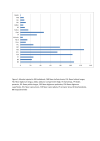Real-life outcomes in spasticity management: features affecting goal achievement
- PMID: 33681772
- PMCID: PMC7903178
- DOI: 10.1136/bmjno-2019-000015
Real-life outcomes in spasticity management: features affecting goal achievement
Abstract
Background/objective: Spasticity is a complex and common condition but there is a lack of 'real-world' data on goal setting and spasticity treatment, as well as identifying those features that might be associated with goal achievement. Our aim was to provide such data.
Methods: Prospective attenders at a multi-disciplinary spasticity clinic over 2 years followed for consecutive appointments. Patient demographics and doses of botulinum toxin injected were documented. Main outcome was achievement of a primary goal but secondary goals were also recorded. Independent variables were examined for association to the outcome.
Results: A total of 606 goals were set in 224 patients. The majority (75.2%) were achieved with similar levels across active (72.5%), passive (75.7%) and pain (78.6%) goals. However, in terms of the primary goal, active primary goals were achieved less frequently (59.7%) than non-active primary goal (74.2%). A logistic regression confirmed that this was the only independent variable associated with primary goal achievement. The majority of patients (61.6%) required changes to their treatment between appointments, irrespective of time since diagnosis, age or aetiology.
Conclusions: Most goals set in spasticity clinic can be achieved irrespective of type of goal. However, active goals may be harder to accomplish when they are set as a primary goal. This may reflect the desire of individuals to prioritise a desirable goal rather than one that is achievable. While goal setting is important in the management of spasticity patients, very few patient or treatment factors are associated with outcome prediction. Further work needs to identify features that may predict successful outcome.
Keywords: botulinum toxin; rehabilitation; spasticity; stroke; traumatic brain injury.
© Author(s) (or their employer(s)) 2020. Re-use permitted under CC BY-NC. No commercial re-use. See rights and permissions. Published by BMJ.
Conflict of interest statement
Competing interests: Both authors have an interest in goal setting and outcome measurement.
Figures

Similar articles
-
[Impact of integrated upper limb spasticity management including repeat botulinum toxin type A (BoNT-A) injections on patient-centred goal attainment in real-life practice: results from the prospective, observational Upper Limb International Spasticity cohort study (ULIS-III) in a Russian subpopulation].Zh Nevrol Psikhiatr Im S S Korsakova. 2021;121(11):39-48. doi: 10.17116/jnevro202112111139. Zh Nevrol Psikhiatr Im S S Korsakova. 2021. PMID: 34932284 Russian.
-
Results from the Upper Limb International Spasticity Study-II (ULISII):a large, international, prospective cohort study investigating practice and goal attainment following treatment with botulinum toxin A in real-life clinical management.BMJ Open. 2013 Jun 20;3(6):e002771. doi: 10.1136/bmjopen-2013-002771. BMJ Open. 2013. PMID: 23794582 Free PMC article.
-
Factors influencing goal attainment in patients with post-stroke upper limb spasticity following treatment with botulinum toxin A in real-life clinical practice: sub-analyses from the Upper Limb International Spasticity (ULIS)-II Study.Toxins (Basel). 2015 Apr 8;7(4):1192-205. doi: 10.3390/toxins7041192. Toxins (Basel). 2015. PMID: 25856546 Free PMC article.
-
Serial injection of botulinum toxin for muscle imbalance due to regional spasticity in the upper limb.Disabil Rehabil. 2007 Dec 15;29(23):1806-12. doi: 10.1080/09638280701568205. Disabil Rehabil. 2007. PMID: 18033605 Review.
-
Spasticity treatment with botulinum toxins.J Neural Transm (Vienna). 2008;115(4):607-16. doi: 10.1007/s00702-007-0833-2. Epub 2008 Apr 4. J Neural Transm (Vienna). 2008. PMID: 18389166 Review.
Cited by
-
Role of Diagnostic Nerve Blocks in the Goal-Oriented Treatment of Spasticity with Botulinum Toxin Type A: A Case-Control Study.Toxins (Basel). 2024 Jun 3;16(6):258. doi: 10.3390/toxins16060258. Toxins (Basel). 2024. PMID: 38922151 Free PMC article.
-
Patient-reported benefits from nabiximols treatment in multiple sclerosis-related spasticity exceed conventional measures.Neurodegener Dis Manag. 2024 Feb;14(1):11-20. doi: 10.2217/nmt-2023-0040. Epub 2024 Feb 6. Neurodegener Dis Manag. 2024. PMID: 38318862 Free PMC article. Clinical Trial.
References
-
- Spasticity in Adults Management using botulinum toxin. Royal College of Physicians, 2009.
-
- Turner-Stokes L, Fheodoroff K, Jacinto J, et al. . Results from the Upper Limb International Spasticity Study-II (ULISII):a large, international, prospective cohort study investigating practice and goal attainment following treatment with botulinum toxin A in real-life clinical management. BMJ Open 2013;3:e002771. 10.1136/bmjopen-2013-002771 - DOI - PMC - PubMed
LinkOut - more resources
Full Text Sources
